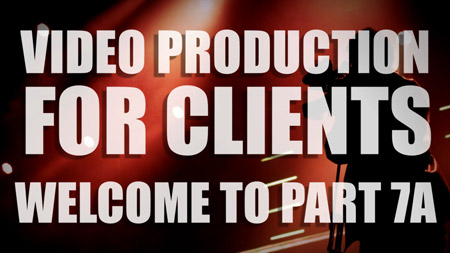7A : How to Leverage Your Completed Videos
(& Avoid the Big Mistake That 90% of Companies are Currently Making.)
A Guide to Everything You Need to Know to Get the Most From Your Video Marketing

ou’ve got your videos.
You love your videos.
But what’s the most effective way to leverage them?
In this Part 7 of Everything you need to know to get the most out of your next Video production, we are going to be looking at video marketing tips and strategies, in other words, what to do with your videos after they’re made.
You’ll learn how to give your videos an advantage in Google results, discover the BIG Mistake that most companies make with Youtube.
How best to use Youtube for your business, and what you can do to help increase how many people share on social media and embed your video on their sites.
And as usual you’ll learn a whole stack more of some very valuable information!
This Guide is going to be broken up into roughly 3 sections.
We’re going to look at a key part to ebey video marketing strategy – where you should be publishing your videos – especially when to choose between hosting them on your own website and putting them on Youtube.
We’re going to look at what you should do to the videos you host on your own site to give them the best leverage and your marketing an advantage to your competition.
Then finally we’re going to cover the Video Giant Youtube: and look at some best and worst practices.
Part 01: Table of Contents:
Each part of the guide has it’s own table of contents so you can get the info you want quickly and easily!
Horses for Courses
Matching the Message with the Medium
Traffic & Conversions (Visitors & Sales)
So What Videos Should Be on My Site?
Video Marketing Tips & Best Practices
(No Matter Where Your Videos are Hosted. )
Remember Value is Contextual Too
Optimise Your Video Titles,
Descriptions Around Video Keywords
Measure Twice, Cut Once ! – Video Analytics
Self Hosted & Third Party Video Hosting Platforms
Video Marketing Tips & Best Practices
(Videos Hosted on Your Site)
Video Sitemaps are a Must
Horses for Courses Matching the Message With the Medium :
Let’s start with probably the most important of our video marketing tips.
Like any type of communication – it’s all about the relationship you have with the viewer and the context of where the communication is taking place.
Another way to put it is content may very well be king – but content only works in the right context in the right place and time.
So before you start making your video/s
Ask yourself “what am I trying to achieve with this video?”
Are you trying to raise your company profile or get more people thinking about your brand?
Are you trying to get them to purchase one of your products or services?
Are you trying to get them to go to your website for more information, or share on Social Media?
Are you wanting to add value in your market place?
Are you providing quick and easy instruction on how to best use a webpage, product or service?
Are you trying to get people to buy a product or service?
Why is this important?
Because then you can match the medium with the message.
And you can design your video content to best work in that setting.
Not all video delivery platforms are created equal – they all have their strengths and weaknesses. By planning to take advantage of the strengths and mitigate the weaknesses you are helping ensure the best chance of success for your video content marketing.
An example of this would be Youtube’s ability to create annotations – these are clickable areas of the video that will perform an action (like subscribe to your Youtube channel) or a link that will take the viewer to a different webpage. (More on that later).
By knowing beforehand that the video is destined for YouTube you can create custom graphic elements that are placed on your video during production that stand out, work with your narrative and as a result get higher CTR (click through rates).
You might be thinking – but isn’t it a good strategy to get my videos out to as many places as possible?
Short answer; no.
Consider the rest of this guide the long answer.
No matter what sort of video you create you can pretty much guarantee that its purpose will be one of these 5 outcomes.
Brand Awareness
Traffic
Conversions
Links
Social Shares
Brand Awareness :
Building your Brand, getting your Market demographic to grow familiar with your brand is a corner stone of all marketing and advertising. The goal is not to prompt an action or sale – it’s simply to build a rapport and add value to a potential customer so that they remember you and think of you favorably when the time comes to purchase or be an ambassador of your brand though referral or social media.
Traffic & Conversions (Visitors & Sales) :
These goals are to get visitors in front of what you have to offer, and provide enough information to help your potential customer, comfortable in their desire and choice to purchase from you.
This could link directly to a sales offer or could be to get a visitor to perform an action that will further them in sales funnel whose ultimate goal is to sell to them one or more services or products.
Links & Social Shares :
These two outcomes can go hand in hand with all of the above outcomes – and can drive views to your videos so that they can then achieve the above goals.
As a general rule of thumb (there are exceptions), the outcome or goal of your video will determine where you should place your video.
Traffic and Conversion oriented videos should be self-hosted or hosted with a paid video platform and live on your branded website.
Brand Awareness videos, especially videos that you want to share with people who are apathetic to your brand, don’t know that you exist or are yet to take any action that would make them part of your sales funnel should be placed on YouTube.
Links: especially for SEO purposes are always best to make sure that the content is only available on your own website – that way anytime you get shares and links you get traffic directly to your site to try and get conversions while helping your video to rank in the Google Search results at the same time.
Note: Building links to Youtube videos can also help get them ranked in the Google search results and even on Youtube. (but this is a little advanced for this guide).
Social shares: In this respect social shares are good for videos placed anywhere you want your videos seen and shared. Just remember to match the medium with the message.
YouTube or Not YouTube
But should your company even be marketing on YouTube in the first place?
You’ll need to jump on YouTube to do some research and answer this question:
Is a good chunk of my target market or the influencers of my target market actively searching Youtube to be informed, educated, or entertained, especially if this content is related to your industry?
If so then your answer is a very probable yes!
So What Videos Should Be on My Site ?
Here’s a list that will help you work out which video content is better hosted on your site and shouldn’t be placed on YouTube
Put these Videos on your site;
If your content is all about your product, and make the most sense to viewers who already know a bit about you – or are part of the way into a sales or conversion funnel. (conversions and traffic)
If you are trying to get a Video result in the Google Universal search results that will send traffic back to your website.
The Universal Search results are simply the search results where Google shows you not just websites results but images, video and pdf’s – this is the default for most users now.
Be aware – if you have the same videos on your site as well as YouTube, in most instances the YouTube videos will outrank those of self-hosted in the search results meaning you can ruin your own chances of sending traffic to your site by sending them to Youtube instead.
As you’ll see in the Youtube section below – the video giant does a horrible job in sales conversions and sending traffic to your site.
If you have created videos with the primary goal to get embedded elsewhere, to get social shares and links that are to link back to a specific page on your website.
The reason for this is embedded Youtube videos only link to YouTube.
Hot Video Marketing Tip!
OK we kind if lied in the last point, we should have said: “embedded Youtube videos normally only link to YouTube.
You can in fact modify the Youtube embed code to contain a link to your site, you may need a small amount of html knowledge to do this. But note, while this may be good for SEO reasons – a YouTube Video will all ways lead back to YouTube.
Video Marketing Tips & Best Practices.
(No Matter Where Your Videos are Hosted. )
Fran Kern – One of the most successful Internet Marketers says (we are paraphrasing here) that in today’s cynical, saturated, savvy market, the new way / the only true sustainable way to market is to make sure that every piece of marketing Video or otherwise should always provide some value to your chosen audience.
We couldn’t agree more: remember that success of your marketing hinges on the customers liking what your brand stands for and trusts your brand to solve their problem or need.
It doesn’t matter if you are trying to sell something, get them to think better of your brand or share your content – in the end the only reason they will do that is if you provide value.
But please note: Value is contextual as well as subjective.
If you are offering great detailed information about how to use all sorts of various products when the viewer is only interested in being entertained then information at that time and place is worthless.
Think about the best places each of your videos can provide the most value.
Share Your Value in Online Communities.
Look at forums, LinkedIn Groups, Facebook and Google + Community groups that are interested in your Companies expertise.
If you find a way to fulfil a need, are helpful or answer a question with your videos then post them here.
Just make sure to provide value in a short post first and suggest that people will get further value by watching the video and then leave a link.
Also be sure to follow the rules of each individual group.
Make It Easy for Your Videos to be Shared & Embedded.
It goes without saying that the easier it is for people to share you content the more people will end up seeing your content!
This is very easy with Youtube (see the Hot Tip above to add a link back to your site.)
For videos that originate from your site – make sure you pick a solution either via a video player or third party Video hosting platform that will make this easy to do.
Remember Value is Contextual Too.
So group your videos together under theme / subject.
On YouTube you should create playlists with these videos grouped together.
On your site, make sure that your videos are easy to navigate between, consider using a portfolio or video gallery with categories and tags so that people can find what interests them quickly and easy.
By putting each video on their own separate page you will allow the search engines to index each video individually which is a great for getting your Vids into the search results.
Just make sure to have plenty of text on each video page – have a text based description on what the video is about.
Optimise Your Video Titles, Descriptions Around Video Keywords.
Did you know that videos dominate Googles Universal search results by 65%?
Whether it’s your videos on Youtube or on your site, having a video search result in Google is a great source of traffic.
But videos do not appear in all of Google’s universal search results.
The big G determines which results will likely have video results and which don’t – so do your research first and try and discover which words already have videos appearing in the search results.
Then optimise your videos around these Keywords.
Make sure to strategise which keywords will be optimised for each video – so that you are not competing against you self (especially with YouTube videos) – this will also ensure that you can get traffic from as broad a range of search terms as possible.
Here are some words that often turn up as Video Rich snippets in Google
what is
hands on
review
tutorial
test
unboxing
training
first look
how to
demonstration
explanation
video
comparison
guide
Note: The Art of Video optimisation is its own entirely different subject, we are just going to cover this as it pertains to your Video Marketing Strategy.
Measure Twice, Cut Once ! – Video Analytics.
Make sure you measure the success of you videos in mot just views but actual engagement – How long did they watch the video when did they leave?
You should be paying attention to analytics not just after a video is created but using your analytics to determine and learn what you want to achieve and how. So measure twice – and cut your video once!
Self Hosted & Third Party Video Hosting Platforms.
What Are Third Party Video Hosting Platforms?
These are Video Solutions that provide the architecture, video storage, bandwidth, video players and various tools such as analytics and social sharing for you to host your videos on your site or where ever you choose (and have permission to of course).
These are not free – but depending on your budget may well be worth the cost.
Some of the best solutions currently in the market are:
Wistia
Brightcove
Vimeo Pro
Viddler
Vzaar
What Are Self Hosted Video Solutions?
This is where you place your videos either on your own server or pay for server space on a service like Amazon S3.
Then you provide third party Video players and Solutions to embed the videos on your site.
Some of the Leading Video Players for Self Hosted Solutions are:
JW-player
Easy Video Studio
Simple Video Pro
The last two of these have their own individual powerful features that can truly take your video marketing to the next level.
Note: These players also allow you to embed Youtube and Vimeo Video’s into them also.
Video Marketing Tips & Best Practices.
(Videos Hosted on Your Site).
The following are ways you can make sure the videos on your website are giving you the most value.
Video Sitemaps are a Must.
A must have is a video site map – this is an html page that tells the search engines about every video you have on your site and where they will find them.
As a result every video needs a page where the video is found, this is why the general rule of thumb of one video per page makes the best sense.
For ease of use it’s best to choose an online video platform or player that will automatically create a video site map for you and add videos to it each time you add a video to your site.
HTML5 Player or Bust !
Speaking of video players – it’s very important that your videos are in mp4 format (and then mp5 when it is released) and are played through a HTML 5 player with flash fallback.
This ensures that your videos will be compatible for most devices and operating systems.
Many companies fall into the trap of not making sure that their videos work on mobile systems (Apple IOS are problematic with flash videos), and as result lose out in a huge segment of their market reach.
Also never use iframes for your videos.
Master Your Metadata.
Google, Facebook, Twitter and many other sites use descriptive information that gets placed into the html code that doesn’t appear on the page to the viewer – this info is commonly called meta data.
By making sure you add this meta data based around the keywords and such that you want to be found for you can maximise the chance that your Videos will be found and indexed in the various search engines and sites.
In particular you should be adding Scheme.orgs micro data as well as Facebook’s Open Graph and Twitter Card Tags.
Use Transcriptions to Your Advantage.
By creating transcriptions of each of your videos and adding them to the html of your page (or even in a drop down box on the page) you give your videos a huge advantage to get indexed and picked up by Google for the search results.
The most ideal solution is attach a closed caption file (sub title formatted) to your video player, and also include a link on the page to an .srt file or any other TTML compatible format.
It may sound a little technical – but getting your video team to do this is well worth the effort.
Consider Using Interactive Video Features.
Thanks to the advances that HTML5 has brought – many video platforms and video player solutions offer extra functionality like adding clickable buttons and link inside the video.
You can also do in-video surveys or quizzes – or pause a video as the user scrolls down the page and auto start another video as it appears on the page further on.
Brain storm the ways in which you can use video on your site to increase the user experience and help the visitor on your site.
For example you could have an intro video on your home page welcoming the visitor and asking what service or info they are looking for with an in-video button for each choice – combined with a call to action – the visitor then clicks on the button and get directed instantly to what they are looking for.
This method can work to even direct different market sectors to the correct page so that you can make sure that they are on the page that will empathise with them the most.
“If you run your own Small to Medium sized company click the red button and if you are part of a larger corporation click the blue button now!
Coming Up In 7B !
We hope you have found our first part of mistakes valuable.
In Part B we’ve got more video marketing tips. We are going to look a Youtube – the right way and wrong way to use it and what to do make sure that your videos have best chance to be seen shared and commented on!
Video Production for Clients Guide Table of Contents:
Here’s An Index of Every Chapter:
So you can get the content that interests you the most!
02 Choosing the Right Video Production Type
for Your Business
4A: The Video Production Process,
How Professional Video’s are Created
4B Phase 2: Production – Lights Camera Action
06: How Long Does a Video Production Take?
7B: How to Leverage Your Completed Videos.
Self Hosted Vs YouTube
08: Common Mistakes and Pitfalls
Unsuspecting Companies Make
Getting A Video Production Created.
09: How to Make Sure That Your Next Video Production
is Created Stress & Risk Free… …and an Elephant
Ready To Get Started?
Why Rockmans Creative Media?
Rockmans Creative Media brings a professional skill set and over 18 years ongoing television experience to your video project.
We understand that we are custodians of your brand.
Our videos are unique, and are tailor-made to meet your company objectives.
We know how to produce engaging, attention grabbing and interesting videos.
Email Us At Sales@rockmanscreativemedia.com.au or fill out the contact form.



